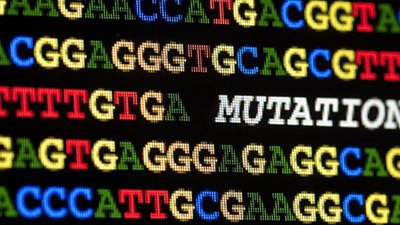
Scientists Admit Genetic Data Timing Uncertain
“The inability to observe past mutation rates means that the timing of events from genetic data remains uncertain,” report Cambridge geneticists.1
News Source
The gorilla, like the chimpanzee and orangutan, now has its genome sequenced. Cambridge researchers report a few surprises. Nevertheless, they hope according to their leader Richard Curbin to discover “what happened genetically in our evolutionary history, and of how those genes affect the brain and other properties that make us modern humans.” They are searching for “genetic factors that led to the emergence of human thought.”
Molecular clock calculations for divergence from our proposed apelike ancestor were “at variance with certain aspects of the fossil record, including several fossils which have been proposed—though not universally accepted—to be hominins, and therefore to postdate the human-chimpanzee split,”2 the researchers write. “Indeed, the relationship between molecular and fossil evidence has remained difficult to resolve despite the accumulation of genetic data.”3
In an effort to explain this discrepancy, the researchers suggest “mutation rates changing over time.”4 They add, “An alternative explanation for the apparent discrepancy in fossil and genetic dates (leaving aside the issue of whether fossil taxa have been correctly placed) is that ancestral demography may have affected the genetic influences.”5
While evolutionary geneticists would never concede the entire Darwinian presumption underlying their conclusions depends on unverifiable, unobservable past events never seen in the present, they admit “the inability to observe past mutation rates means that the timing of events from genetic data remains uncertain.”6 As a compromise position, they suggest the orangutan, gorilla, and chimpanzee diverged from the common ancestor shared with humans 14 million, 10 million, and 6 million years ago. This solution keeps conventional evolutionary branch points intact, with the chimpanzee remaining the closest human relative, but pushes the timing farther back.
Gorillas and humans also share a surprisingly large number of genes, they report, as do gorillas and chimpanzees.
Gorillas and humans also share a surprisingly large number of genes, they report, as do gorillas and chimpanzees. One of the genes shared by gorillas and humans relates to hearing. Evolutionists have generally thought language developed as a result of human auditory improvements. However, discovery of this special gene in gorillas calls “into question a previous link made between accelerated evolution of auditory genes in humans and language evolution.”7 That leaves evolutionary anthropologists back at square one on the language question. Genetic anthropologist Wolfgang Enard explains, “If you find this in the gorilla, this option is out of the window.”8 As creationist Dr. Jeffrey Tomkins reports in his analysis, the “Gorilla Genome Is Bad News for Evolution”!9
Furthermore, language demands the use of symbols and requires abstract thinking. The question of “when the first genes emerged that made humans capable of abstract thought” remains the puzzle Durbin’s group hopes to solve. Of course, the Bible’s account of history explains the origin of language. God created Adam and Eve fully able to communicate and gave Adam the job of naming the animals.
Molecular clock calculations appear authoritative and factual. Yet molecular clocks depend upon unverifiable assumptions about the unobservable untestable past. For instance, mutation rates must be constant for conclusions to be valid. Even in the short term, that assumption has already been disproven in humans. (See “Molecular Clock Off-Line.”) As these researchers note, such calculations suffer from “the inability to observe past mutation rates.” But the root of the problem goes deeper, to the heart of the statistical methods involved, as we discussed in “.”
Furthermore, dating the fossil record—another possible flaw they mention—is based on additional unverifiable assumptions about a number of uniform constants in the past—from sedimentation rates to radioactive decay rates. And yet beyond the “when” is the question of “how.” How could the genetic information to change one kind of organism into another kind be randomly acquired through genetically destructive mutations? Neither molecular genetics nor the fossil record has produced evidence of transitional forms, only distinct kinds of organisms with variations within the kinds—findings consistent with God’s report in Genesis chapter one that He created all kinds of living things with the inference that they were to reproduce after their kinds.
Statistical percentages of human and ape genome similarity also appear impressive—“Initial comparisons confirm that chimpanzees are our closest relatives, sharing 99% of our DNA. Gorillas come a close second with 98%, and orangutans third with a 97% share.” But many casual observers don’t realize how much bias is built into these numbers. Molecular geneticist and creationist Dr. Georgia Purdom says, “People need to understand that many assumptions by the scientists, like human evolution from an ape-like ancestor, have a direct effect on how the scientists compare the genomes. They compare them in a way that will achieve the conclusion they have already determined is true—that humans and apes share common ancestry. It's truly a case of circular reasoning!”
Not only are “matching” areas preselected for comparison and thereby overemphasized, unmatched areas are systematically ignored. Publicized percentages further disguise the magnitude of ape-human differences. Millions of differences go “uncounted.” (See “How Genomes are Sequenced and Why it Matters: Implications for Studies in Comparative Genomics of Humans and Chimpanzees” and “Genome-Wide DNA Alignment Similarity (Identity) for 40,000 Chimpanzee DNA Sequences Queried against the Human Genome is 86–89%” for more about these methods.)
Even if geneticists determine actual genetic differences that enable humans to think abstractly, they will not have demonstrated how those differences “emerged.” Observation of all such “evolutionary history” about common ancestry is not only clouded by the mists of unconquerable time but actually created by the imaginative assumptions of evolutionists determined to reject the only eyewitness account of human origins—God’s eyewitness account in Genesis telling us He created Adam and Eve in His own image.
Further Reading
- Are Humans and Chimps Related?
- If Human and Chimp DNA Are So Similar, Why Are There So Many Physical and Mental Differences Between Them?
- Chimp Genome Sequence Very Different from Man
- Greater Than 98% Chimp/Human DNA Similarity? Not Any More.
- Genome-Wide DNA Alignment Similarity (Identity) for 40,000 Chimpanzee DNA Sequences Queried against the Human Genome is 86–89%
- Response to Comments on “How Genomes are Sequenced and Why it Matters: Implications for Studies in Comparative Genomics of Humans and Chimpanzees”
- How Genomes are Sequenced and Why it Matters: Implications for Studies in Comparative Genomics of Humans and Chimpanzees
For More Information: Get Answers
Remember, if you see a news story that might merit some attention, let us know about it! (Note: if the story originates from the Associated Press, FOX News, MSNBC, the New York Times, or another major national media outlet, we will most likely have already heard about it.) And thanks to all of our readers who have submitted great news tips to us. If you didn’t catch all the latest News to Know, why not take a look to see what you’ve missed?
(Please note that links will take you directly to the source. Answers in Genesis is not responsible for content on the websites to which we refer. For more information, please see our Privacy Policy.)
Footnotes
- Aylwyn Scally et al., “Insights into Hominid Evolution from the Gorilla Genome Sequence,” Nature 483, 7388 (March 8, 2012): 169–175, doi:10.1038/nature10842.
- Ibid.
- Ibid.
- Ibid.
- Ibid.
- Ibid.
- Ibid.
- Kerri Smith, “Gorilla Joins the Genome Club,” Nature, March 7, 2012, http://www.nature.com/news/gorilla-joins-the-genome-club-1.10185.
- Jeffrey P. Tomkins, “Gorilla Genome Is Bad News for Evolution,” Institute for Creation Research, March 9, 2012, http://www.icr.org/article/6723/.

Answers in Genesis is an apologetics ministry, dedicated to helping Christians defend their faith and proclaim the good news of Jesus Christ.
- Customer Service 800.778.3390
- Available Monday–Friday | 9 AM–5 PM ET
- © 2025 Answers in Genesis



